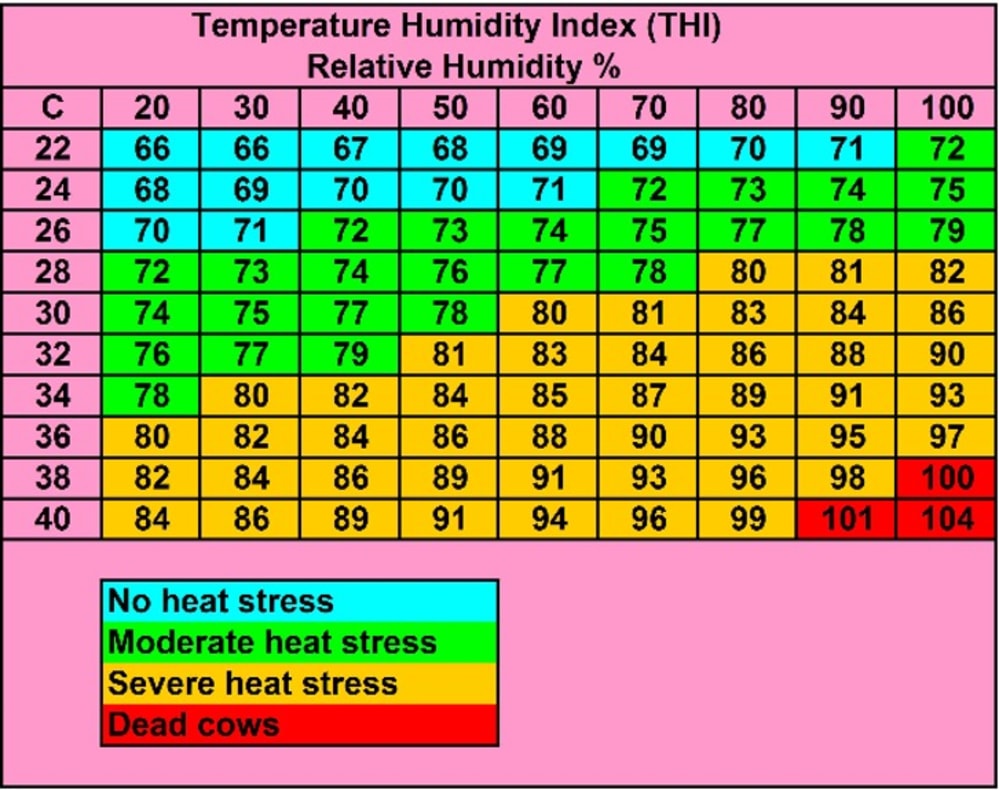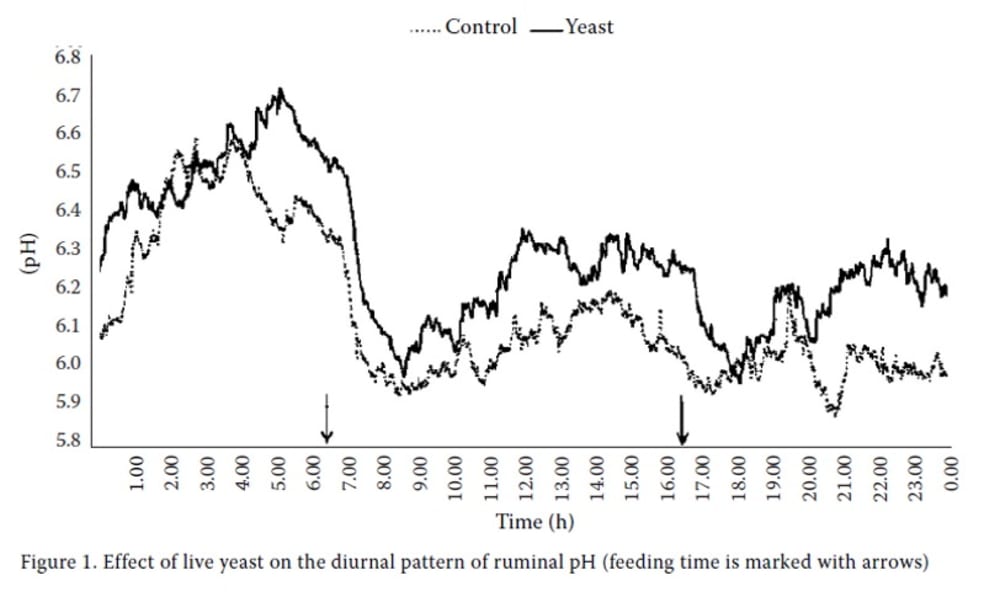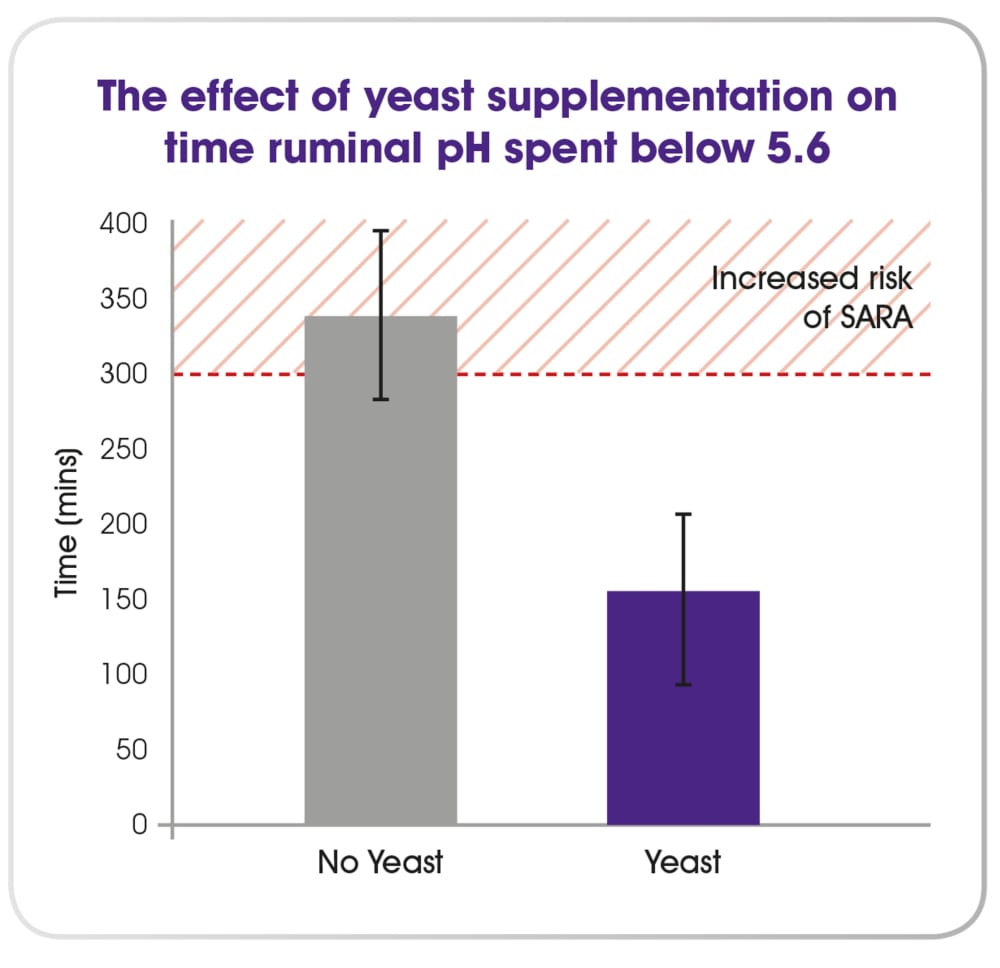Strategies to mitigate heat stress in dairy cows
Published Thursday, 11th May 2023Dr. Dimcho Djouvinov and Dr. Derek McIlmoyle, ABVista
Heat stress occurs in dairy cows when they absorb more heat than they can expel, leading to discomfort, reduced feed intake, poorer productivity and impaired fertility. It can cause significant economic losses. In the US alone, the dairy industry loses between $897 - $1,500 million/year in revenue due to heat stress (St-Pierre et al., 2003).
The harmful effects of high ambient temperatures in production conditions are enhanced by high humidity and insufficient air flow. When the Temperature-Humidity Index (THI) exceeds 72, cows suffer heat stress.
Source: https://www.nadis.org.uk/
Heat stress affects cows in all physiological phases. In dry cows it results in reduced blood flow to the uterus, reduced placenta weight and birth of smaller calves with lower vitality. High yielding cows are more prone to heat stress, especially in peak lactation. Milk production could reduce by 10-25% due to decreased appetite and feed intake, and lower levels of lactogenic hormones. In heat stressed cows, dry matter intake is reduced by 8-12%, and milk yield by 20-30%. It can also affect milk quality, with reduced butter fat content and increased somatic and bacterial cell counts, most likely due to impaired immunity.
Endocrine status of cows can also be negatively affected, together with reduced intensity and duration of oestrus, impaired fertility and elevated early embryo mortality.
The following key management and nutrition actions can help to mitigate the negative effects of heat stress:
- Protect the animals from direct sun radiation
- Increase ventilation rate in barns
- Apply cool water spray
- Reduce animal density
- Allow access to cool drinking water
- Use high quality dietary ingredients to improve nutrient content
- Ensure gradual and on-time adaptation to corrected diet
- Diet to be fed mainly during the cooler part of the day
- Increase feeding frequency with smaller portions.
Specific nutritional strategies to reduce the physiologic impact of heat stress, to support milk yield and health status of cows:
- Time and frequency of feeding. For appetite stimulation, 60-70% of the ration should be fed overnight, when the ambient temperature is lower. Increased feeding frequency reduces the overall heat produced by the animal after ingestion. Offering smaller portions also reduces risk of feed spoilage.
- Forage/concentrate ratio. High production dairy diets normally have a roughage (forage) content of 45-60% of total dry matter intake (DMI), providing a significant part of dietary fibre. More heat and acetate are produced due to the fermentation of more fibrous diets compared to diets with higher levels of grain, where starch is fermented to propionic acid. Hence, it seems logical to reduce ruminal production of acetic acid at the expense of propionic acid by reducing roughage content in the diet. However, this should be done carefully by maintaining sufficient levels of physical effective fibre and Neutral Detergent Fibre (NDF) and preventing concentrates exceeding 60% of DMI.
There is an increased risk of sub-acute ruminal acidosis (SARA) if forages drop too low, leading to impaired rumen function and further depressions in DMI and milk butterfat. Highly digestible roughages stimulate DMI while reducing heat increment, therefore aiding thermoregulation. Brewers grains, cotton seeds and beet pulp are recommended ingredients, as their nutrient content favours a more balanced fermentation pattern in the rumen. - Fat level. Increased fat addition in diets during heat stress is recommended since less heat is released during the metabolism of fats compared to carbohydrates and proteins. This helps in reducing heat production and maintaining normal body temperatures. Supplementing with fats also increases the energy density of the diet, partially compensating for reduced dry matter (DM) and energy intakes. Total fat content should not exceed 6-7% dietary DM content. In practical diets, fat can be added in the form of oil seeds (sunflower or cotton) or ruminally protected fats. Oil seeds should be provided whole to prevent fast release of free oil which in turn can supress rumen fermentation.
- Nitrogen balance. In conditions of extreme heat, cows might experience negative nitrogen balance due to lower feed intake and higher nitrogen excretion – resulting in reduced milk production. The target should be improving nitrogen balance but not simply by elevated dietary crude protein (CP) levels. A study during hot temperatures showed that cows fed diets with 16% CP with a low degradable protein content had 1.5 kg higher milk yield compared to animals fed a diet with 18% CP which was highly degradable (Higginbotham et al., 1989). Correct nitrogen balance in the rumen can be achieved by introducing ingredients with lower protein degradability: brewers grains, distilleries dried grains and solubles (DDGS).
- Electrolyte balance. The Electrolyte Balance (EB) of the ration is another factor to consider. The final dietary EB depends on the content of ions Na+, K+, Mg2+, Cl-, S2- & P2- and can be manipulated by the restriction of one type of ions and supplementation of desirable electrolyte minerals. It is recommended to maintain the following concentrations of minerals as % DM: К – 1.3-1.5; Na 0.5; Mg 0.35 & chlorine 0.35. In conditions of heat stress, increasing EB from 120 tо 460 mEq/kg DM has a positive effect on appetite and DMI of milking cows (West et al, 1992). It is recommended to maintain EB close to 300 mEq/kg DM. Sodium bicarbonate helps in keeping desired dietary Na levels and EB without excessive chlorine content.
- Mineral buffer additives. Improving the buffer capacity of the diet can contribute to maintaining normal pH in the rumen, milk production and butter fat.
- Live yeast (Saccharomyces cerevisiae) supplementation. Heat-stressed cows suffer decreased rumination and reduced amplitude and frequency of rumen contractions. This results in reduced saliva flow and buffering capacity due to increased CO2 loss via panting. Furthermore, a decreased rumen pH impairs fibre digestion efficiency, with rumen fibrolytic bacteria being most affected when rumen pH drops below 6.0.
To counteract the negative effects of heat stress on ruminal efficiency and metabolism and to maintain health status, fertility and performance, live yeast has successfully been used in dairy cow diets during periods of heat stress. Live yeast:
- removes oxygen in the rumen, improving the conditions for growth of bacteria that convert lactic acid to propionic acid, a major energy source for ruminants
- effectively competes with starch degrading bacteria for sugars and reduces their growth and subsequent lactic acid production
- help to prevent accumulation of lactic acid in the rumen, regulating the rumen pH and limit the risk of both clinical and subclinical acidosis.
During Europe’s 2019 summer heatwave, herds which were treated with a double dose of live yeast (100x109 CFU/head/day) saw no significant drop in milk yield and no strong daily fluctuations.
Heat stress can result in higher bicarbonate loss in the urine, causing less bicarbonate being available to help buffer acids in the rumen and pH is reduced, leading to SARA.
Systematic measurement of ruminal pH for a 24-hour period indicated that daily live yeast supplementation contributed to a higher pH versus non-supplemented animals (Krizova et al., 2011) (Figure 1).
In SARA challenged cows Alzahal et al. (2014) found a positive influence of live yeast on rumen pH and in particular the time spent below pH 5.6 (Figure 2). Levels of fibrolytic fungi and the main fibre degrading bacteria were increased, indicating better fibre digestion and the number of lactate producing microorganisms reduced.
Figure 2: The effect of live yeast (Saccharomyces cerevisiae) supplementation on time ruminal pH spent below 5.6 (Alzahal et al., 2014).
Conclusion
There is no single approach to alleviate heat stress for dairy cows. Effective management and nutritional strategies are required to balance the homeostasis of the animal and help support feed efficiency, productivity and reproduction.
Supplementing the diet with live yeast (Saccharomyces cerevisiae) can be a successful part of these strategies to help counteract the negative effects of heat stress.
Latest news
Stay ahead with the latest news, ideas and events.

Online Feed Fibre Calculator
Calculate the percentage of dietary fibre in your feed
Our calculator is designed for nutritionists and uses averages of global raw materials to calculate the dietary fibre content (plus other more in-depth fibre parameters) of finished animal feed. These parameters are available within AB Vista’s Dietary Fibre analysis service (part of our NIR service).
Sign up for AB Vista news
A regular summary of our key stories sent straight to your inbox.
SUBSCRIBE© AB Vista. All rights reserved 2025
Website T&Cs Privacy & Cookie Policy Terms & Conditions of Sale University IDC policy Speak Up Policy



























